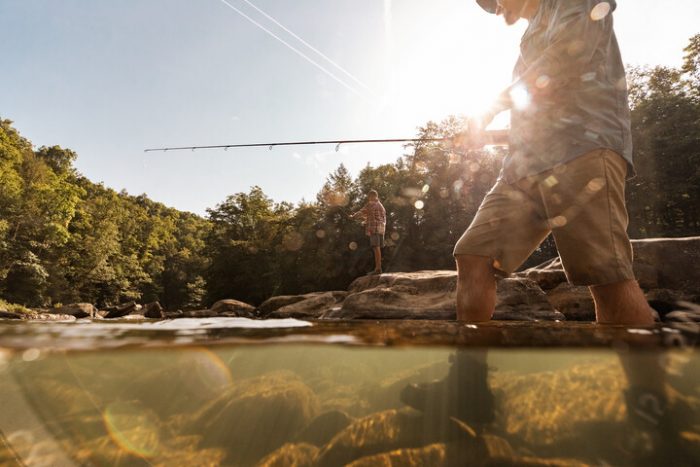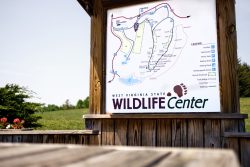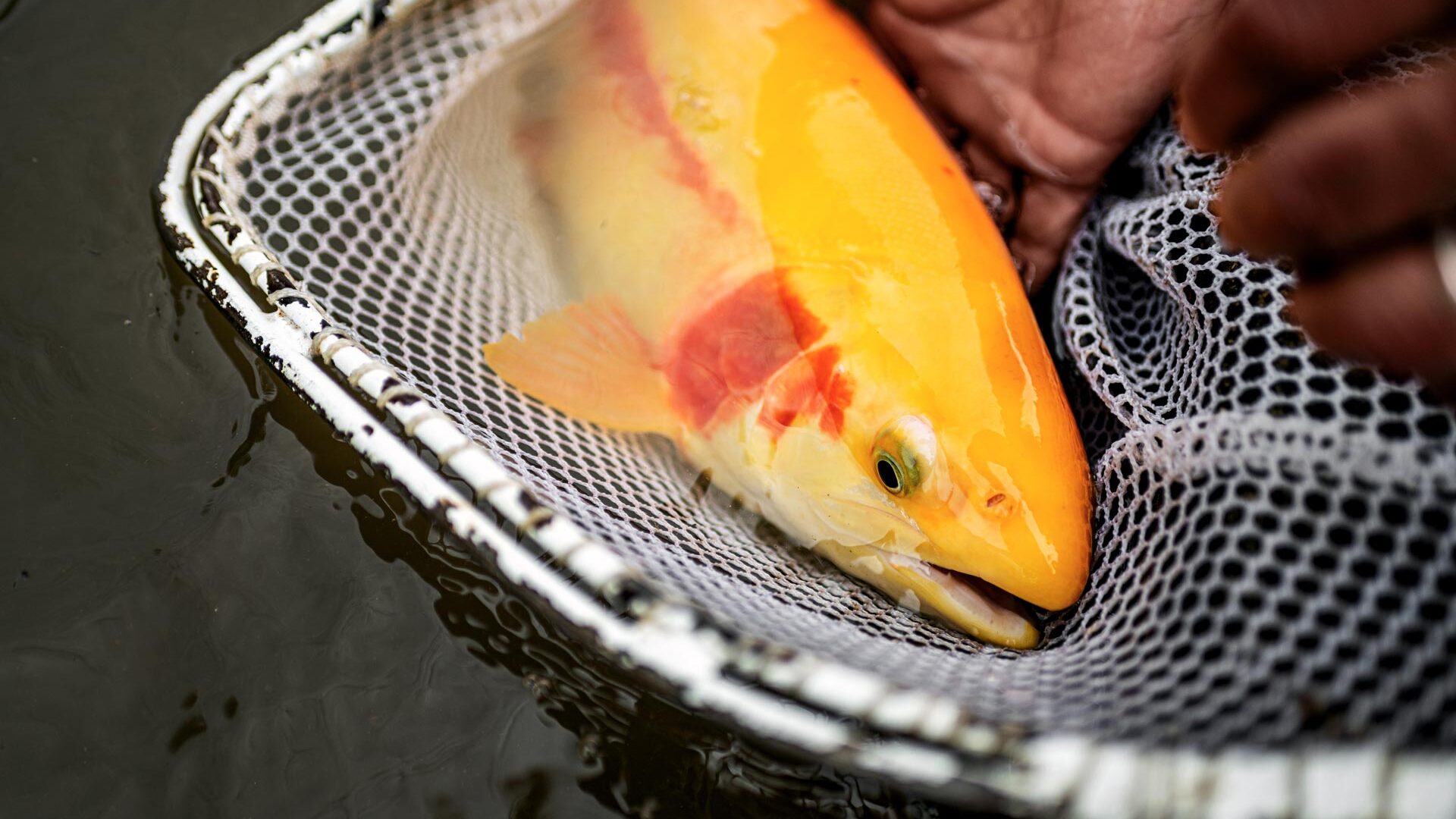West Virginia fish hatcheries and fish stockings began in the late 1800s, but it wasn’t until the 1950s that larger hatcheries were built, and fish production and stocking began to increase. The purpose of the hatchery program is to provide gamefish for recreational angling opportunities. Without the hatchery program, many of the state’s waters would not sustain recreational sport fishing at the current level. This is especially true for most stocked trout waters due to increased temperatures during summer months that prevent fish from surviving year around.
WVDNR currently manages and operates nine fish hatcheries statewide. Seven of these hatcheries are cold water and include the Bowden, Edray, Petersburg, Reeds Creek, Ridge, Spring Run and Tate Lohr hatcheries. These cold-water hatcheries rear trout species including rainbow trout, golden rainbow trout, brook trout, brown trout and tiger trout. The two warm-water hatcheries are Apple Grove and Palestine hatcheries. These facilities raise warm-water species that commonly include walleye, musky, channel catfish, blue catfish, striped bass and hybrid striped bass. Additional warm-water species are cultured and stocked when fish biologists identify specific needs. Annual fish stocking from all WVDNR hatcheries averages more than two million fish per year.
WVDNR has several trout hatcheries that culture and maintain their own brood stock for spawning. After spawning, eggs and fingerling trout are provided to the remaining hatchery facilities for grow-out. Rainbow and golden rainbow trout are spawned starting in August, with brown and brook trout spawned in September and October, respectively. Trout eggs are hatched indoors and grown to fingerling size prior to moving to outside pools and/or raceways. Fingerling trout are moved outside as soon as raceways and pools are emptied and sanitized during the spring stocking season. Fingerlings are then reared to catchable size for the following spring stocking. At the time of stocking, most catchable sized trout are 1 1/2 years old with a target weight of three quarters of a pound.
Warmwater fish are cultured through several sources: collecting wild brood stock, the purchase of eggs or fry from a private vendor or trading surplus of various species with other state agencies. Wild brood fish are spawned at the two warm-water hatcheries and then returned to the wild at the location of collection. Once eggs are hatched for warm-water fish species, the young fry are placed in grow-out ponds until they reach fingerling size. Ponds are drained in early summer and the collected fingerlings are distributed to various waters across the state. Some of the ponds are not drained and the fingerling fish are grown to a larger size, known as advanced fingerlings; the additional growth increases their survival and helps with avoiding predation. These advanced fingerlings are stocked during the fall.
The allotment of fish stocked in a body of water is primarily determined by its size and acreage. In the trout stocking program, annual allotment is determined by multiplying the water acreage included in the stocking area by number of fish to be stocked per acre annually. This is referred to as the stocking factor. The stocking factor can vary throughout the stocking season and is based on the pounds of trout available in the hatchery system for stocking. Changing the stocking factor means all stocked waters are adjusted to receive more or less pounds of trout on an equal basis. This allotment method makes for fair and equitable fish distribution across all waters statewide.
The other factor considered in distribution of fish is the stocking suitability. Stocking suitability ranges from zero to one and is a measure of numerous biological and sociological factors. One of the main considerations when determining the stocking suitability is the number of available stocking locations and angler access to the stream or lake for fishing. Other factors include the availability of parking, bathroom facilities, public versus private stream-side ownership, and the potential impact to other species and the ecosystem.
The frequency of stocking incorporates variables such as distribution/location distance from a facility, allotment designated to the water body, waters located in similar areas, truck capacity and staffing. Trout stocking allotment determines the pounds of trout stocked annually in each water. Therefore, if a body of water receives weekly trout stockings, the total annual allotment is divided by 16 (the number of weeks in the spring stocking season). Waters receiving biweekly stockings would be divided by eight, and monthly stocked waters divided by four. Therefore, an increase in stocking frequency means the number of stockings increase but the number of fish stocked annually remains the same.
Warm-water game fish species are usually stocked annually. Most fingerlings are stocked in May and June. However, advanced fingerlings are retained at the hatchery and stocked during the fall. These advanced fingerlings have greater survival when stocked but are difficult and costly to culture and require the obligation of hatchery space for a much longer time period.
Fish food is the biggest cost in rearing fish. Most fish food is used at trout hatcheries because fish are reared to about 1 1/2 years of age prior to stocking. The distribution and stocking of fish across the entire state is also a significant expenditure. High weight capacity trucks and customized tanks that provide aerations to fish during transport are essential pieces of equipment to ensure fish arrive safely to and healthy at their destination. Hatchery facilities also have large maintenance costs to ensure equipment and buildings are operating adequately and efficiently. Additionally, there are 40 full-time staff members and temporary seasonal employees working every day of the year to make it all happen.
Based on annual production records, the average cost of stocking a single catchable sized trout ranges between $3 and $4. The cost of stocking warm-water fish varies widely because most are stocked as fingerlings, spending less time at the hatchery with less stocking frequency.
Funding for WVDNR hatcheries is provided by license buyers and matching funds from the U.S. Fish and Wildlife Service Sport Fish Restoration program. Funds from license and trout stamp purchases finance the hatchery program. Revenue received from trout stamp purchases only covers about one-quarter of the annual hatchery operation costs. The remainder of the funding comes from the Sport Fish Restoration Program. Sport Fish Restoration funds are acquired through the excise tax on fishing equipment manufacturing. These collected taxes go directly to the U.S. Fish and Wildlife Service and are then distributed back to WVDNR specifically for hatcheries and fish management programs. No general revenue money from state income or sales tax is available to WVDNR, and 100 percent of license revenue from anglers goes directly back to fish culture and management.
Many challenges are at hand when conducting intense fish culture practices. The biggest challenge at any hatchery facility is water supply. Trout hatcheries must have an extremely large water supply with water temperatures near 55 degrees. Trout require large amounts of dissolved oxygen in the water to breathe adequately and can die when water temperatures start getting above 70 degrees. During summer months with limited rainfall, decreases in water flow to hatchery facilities severely impact trout health and growth. Hatchery staff commonly install additional aeration units and equip rearing units with liquid oxygen to help the trout survive the low-oxygen conditions resulting from limited water. The staff may also need to limit food and, in some cases, temporarily suspend feeding. When fish feed, they consume more oxygen and create waste and chemical by-products that can cause toxic conditions when flows are not adequate to support good water quality. Therefore, cool, wet summer conditions mean larger fish for stocking the next spring while summer drought conditions result in limited growth.
Warm-water hatcheries also have many challenges directly attributed to weather conditions. Hot, dry summers can limit oxygen availability in grow-out ponds and often results in algal growth that can be toxic. Fish can also become tangled in algae and vegetation when ponds are harvested. Because warm-water fish species have an optimal growth temperature much higher than trout, extended periods of cold weather not only reduce the fish feeding activity but also hinder the reproduction and growth of micro-organisms that are a food source for young fish in grow out ponds.
Many types of bacteria, fungus, and viruses can infect hatchery reared fish. Fish species at both warm-water and cold-water hatchery facilities are susceptible to disease risks and must be monitored daily for any signs of infection from potential pathogens. One of the most common sources of fish disease in hatcheries comes from birds and animals visiting the facility. Birds and other animals carry diseases from wild fish and can spread the disease throughout the facility. Additionally, the birds and animals pose a significant predatory threat to fish at the facilities. Bio-security protocols and hatchery procedures to prevent disease are critical to keep fish populations healthy and growing.




